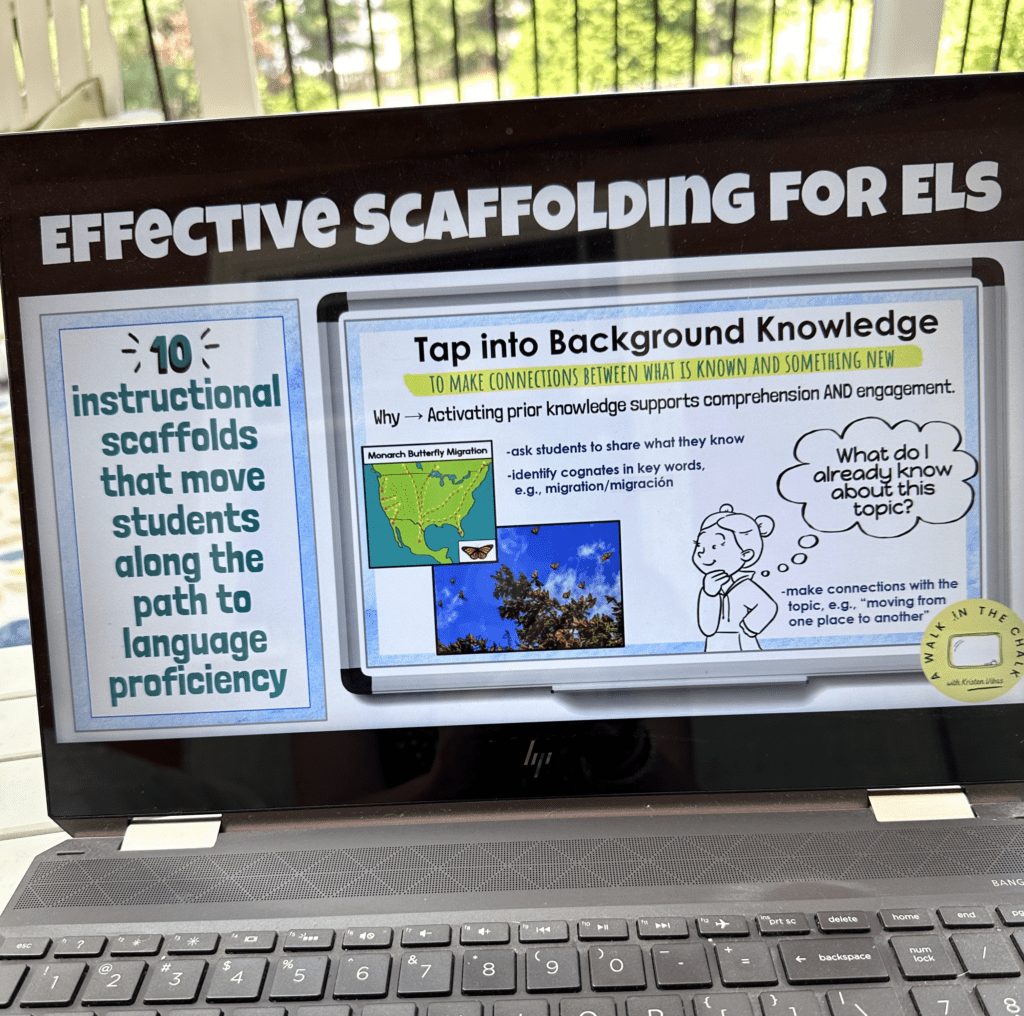An important role of any ESOL teacher includes sharing expertise with general education colleagues on best practices that support English language development. One way to do this is by sharing and demonstrating highly effective instructional scaffolds and strategies for English learners that make the grade level content more accessible.
Teachers want to increase the instructional value provided to their multilingual learners, but sometimes the task seems overwhelming. Modeling one or two scaffolds at a time for our colleagues can be a great way to share highly effective best practices for our shared English language learners. Looking for some PD slides to share with colleagues? I’ve got you;)
Give mini-PD on Best Practices for ELs
By sharing an instructional scaffold and showing how it could be used with the grade level content we can build capacity with our general education colleagues, which in turn has a positive impact on instruction for our multilingual learners.
Step 1: Identify possible professional development opportunities when you could share a PD “nugget” with teachers.
- a weekly meeting
- a common planning time
- monthly mini workshops
- beginning/middle of the year staff development
- CLT meetings
Step 2: Share and demonstrate one (or two) scaffolds at a time. I share one strategy every other week with my grade level teachers during their LA CLT meeting. I take just the first few minutes at the beginning of the meeting to share one scaffold, and demonstrate how it could be implemented with the current or upcoming content being taught.
After sharing, it’s important to give teachers the opportunity to implement the new scaffold before introducing a new one. Ultimately, they’ll have all 10 of these highly effective instructional scaffolds to incorporate throughout their instruction and across all content areas. Win! 🙌
Keep reading to grab my PD slides. 👇
What is a scaffold?
A scaffold is a temporary support that enhances comprehension and learning. Scaffolds are used to differentiate instruction and are necessary for optimizing student success. Here are a few examples of scaffolds for students at different English proficiency levels.

10 Instructional Scaffolds and Strategies for English Learners
1- Visuals – to provide context and activate background knowledge
2- Sentence Stems and Sentence Frames – to support spoken and written output

3 – Comprehensible Input: Rate of Speech, Enunciation, Word Choice and Gestures – to present information in a way that is better understood
4- Modeling – to explicitly show what something looks like
5- Structured Discourse – planned opportunities to use academic language during “low-stress” activities. Model first and provide sentence frames or starters.
6- Graphic Organizers – to help students organize information – add language supports such as images, word banks, and sentence starters depending on student needs
7- Frontload Key Vocabulary – pre-teach essential terms prior to reading

8- Prevent Cognitive Overload: chunk information, pause to process, keep information concise – to keep working memory from becoming “maxed out” due to too much information or too many tasks
9- Total Physical Response – linking vocabulary and concepts with physical movement
10- Background Knowledge – to make connections between what is known and something new

👉 When teachers are provided with tools that support meaning and promote comprehensible input, they feel more confident in their teaching practices.
👉 When students are provided instruction that incorporates effective scaffolding, they have greater access to the content and curriculum, making instruction more equitable for all learners.
Remember – What’s good for ELLs is good for ALL. 🙌
✨FREE DOWNLOAD✨
To receive your own copy of my 10 effective scaffold slides to use as professional development opportunities with your colleagues and staff, join my monthly newsletter!
In the newsletter I’ll be sharing valuable information through tips, strategies, lesson ideas and resources. Click on the image below to join. 👇


Hope to see you inside the Newsletter! 🙌
Looking for tips on how to set up a successful push-in or co-teaching classroom? Check out this post!



